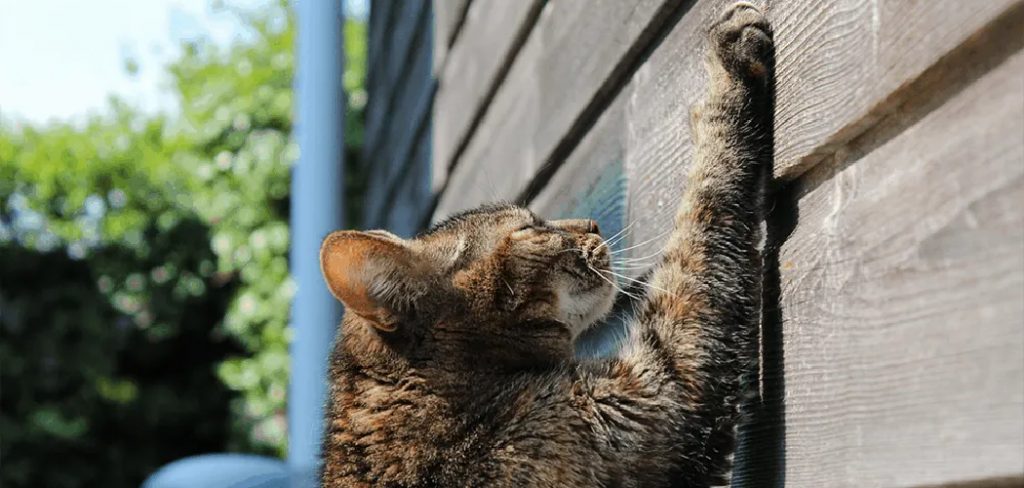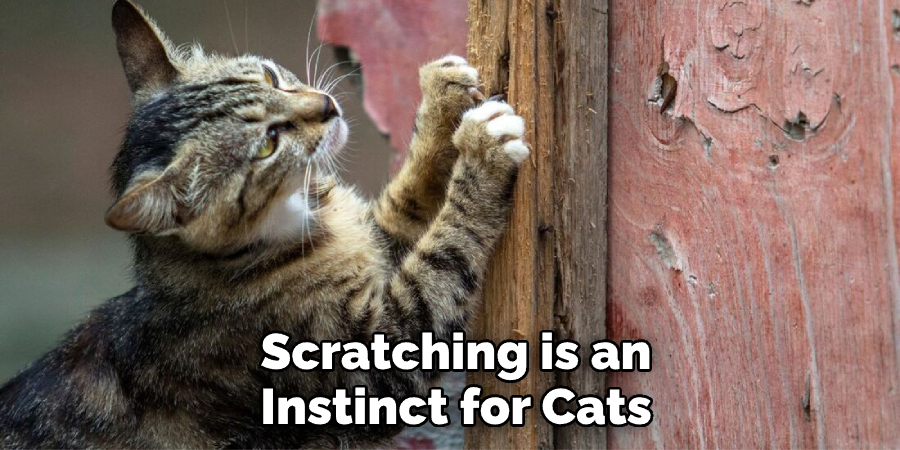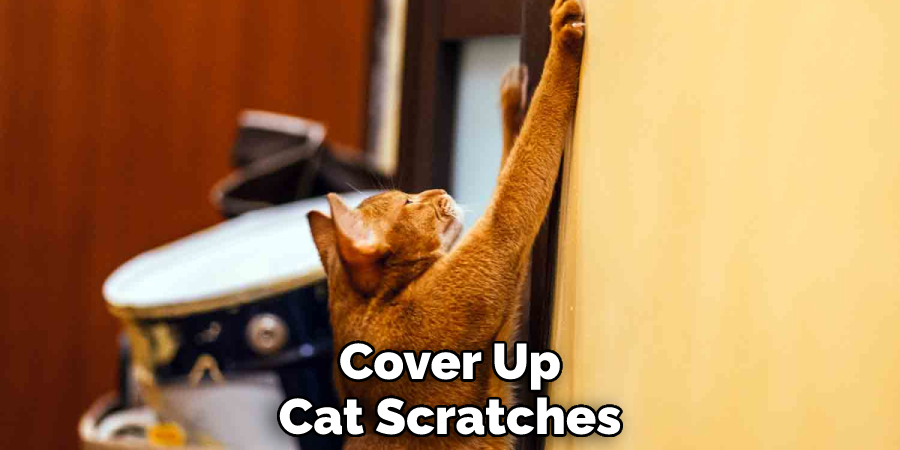Has your cat ever scratched your walls? It’s not a pleasant experience, that’s for sure. But don’t worry – we’re here to help. In this post, we’ll share some tips on how to fix cat scratches on wall. So read on and end the damage your kitty is inflicting!

Summary: Cats scratch to mark their territory, and it is important to understand this behaviour in order to correct it. Redirecting the scratching behavior and providing appropriate scratchers can help prevent further damage. If there are already scratches on the walls, putty or wood filler can help repair them, as well as furniture covers or guards. Pheromone sprays and diffusers may also be useful. In more severe cases, professional help should be sought.
What Are Cat Scratches on Wall?
If you’ve ever owned a cat, chances are you’ve come home to find scratches on your walls. While it may be tempting to scold your feline friend, it’s important to remember that scratching is an instinct for cats. In the wild, cats use their claws to climb trees and hunt prey. When domestic cats scratch furniture, they’re simply satisfying their need to scratch. However, this behavior can still be frustrating for owners.
You can do a few things to discourage your cat from scratching the wall. First, try placing a scratching post near the area where your cat likes to scratch. You can also try covering the area with double-sided tape or aluminum foil. If all else fails, you may need to have your cat declawed. This is a controversial procedure, so be sure to do your research before making a decision.

Why Should You Fix Cat Scratches on Wall?
Cat scratches on your wall can be more than just an eyesore. They can also lead to serious damage if left untreated. Cat scratches typically fall into two categories: surface scratches and deep gouges. Sharp claws usually cause surface scratches and typically only penetrate the paint or wallpaper. On the other hand, deep gouges can penetrate through the drywall, exposing the underlying wood or metal framing.
In addition, deep gouges are more likely to trap moisture, which can lead to mold or mildew growth. As a result, it is important to repair both types of cat scratches as soon as possible. Patching up surface scratches is relatively straightforward, but deep gouges will require more extensive repairs. In either case, taking care of cat scratches is an important part of maintaining your home in good condition.
9 Tips to Follow on How to Fix Cat Scratches on Wall
If you’re a cat owner, chances are you’ve come home to find your kitty has left some claw marks on your wall. While it may be tempting to scold your feline friend, it’s important to remember that cats scratch for different reasons. For instance, cats use scratching as a way to mark their territory or relieve stress. Regardless, knowing how to fix cat scratches on walls is important.
Luckily, you can repair the scratches in a few different ways. We’ve outlined some tips below on fixing cat scratches on the wall.
1. Understand that Cats Scratch to Mark Their Territory
Before you start trying to repair the damage, it’s important to understand why your cat is scratching in the first place. As we mentioned, cats will often scratch as a way to mark their territory. They do this by leaving their scent on objects in their environment.
If your cat is scratching furniture or walls in your home, they’re likely trying to claim those objects as their own. In other words, they’re trying to tell other animals that this is their territory.

2. Use a Pheromone Spray or Diffuser
One way to help deter your cat from scratching furniture or walls is by using a pheromone spray or diffuser. These products release a synthetic version of the pheromones that cats naturally produce. When these pheromones are released into the air, they help to calm and relax cats. As a result, your cat may be less likely to scratch as a way to relieve stress.
3. Trim Your Cat’s Nails Regularly
Another way to help prevent your cat from damaging your walls is by regularly trimming their nails. This will help to keep their claws from getting too sharp. Additionally, it’s a good idea to use nail caps or covers if you’re concerned about your cat scratching furniture or walls.

4. Provide Your Cat with A Scratching Post or Pad
One of the best ways to prevent your cat from scratching furniture or walls is by providing them with an alternative scratching surface. This can be in the form of a scratching post, pad, or tree. Cats love to scratch, so giving them a designated object to scratch will help keep them from damaging your furniture or walls.
5. Redirect Your Cat’s Scratching Behavior
If you catch your cat in the act of scratching furniture or walls, try to redirect their behavior. For instance, you can pick them up and place them in front of their scratching post. Additionally, you can try using a spray bottle filled with water to mist them when they start to scratch lightly.
6. Cover up The Scratches with Paint or Wall Covering
One way to cover up cat scratches on walls is by painting or wallpapering over them. This is a quick and easy way to fix the damage. However, it’s important to note that this method will only work if the scratches are not too deep.

7. Repair the Scratches with Putty or Wood Filler
You may need to use putty or wood filler to repair the damage for deeper scratches. This can be a bit more time-consuming than simply painting or wallpapering over the scratches. However, it will help to fill in any deep gouges so that your walls look good as new.
8. Use Furniture Covers or Guards
If your cat is scratching furniture, you can try using furniture covers or guards. These products are designed to protect your furniture from scratches. Additionally, they can help to deter your cat from scratching in the first place.
9. Seek Professional Help
If you’ve tried all of the above methods and your cat is still scratching furniture or walls, it may be time to seek professional help. A behaviorist or veterinarian can help you identify the problem’s underlying cause and devise a plan to solve it.
That’s it! You’ve now learned how to fix cat scratches on walls. Remember, it’s important to understand why your cat is scratching in the first place. Additionally, you can try using a pheromone spray or diffuser, trimming their nails, providing them with a scratching post, redirecting their behavior, or covering up the scratches with paint or wall coverings.
How to Prevent Cat Scratches From Happening in The First Place
Cat scratches can be a real pain, both literally and figuratively. Not only do they hurt, but they can also lead to infection. In addition, cats often like to scratch furniture, damaging your belongings. Fortunately, you can do a few things to help prevent your cat from scratching you or your belongings. First, ensure your cat has a scratching post to help satisfy its natural need to scratch.
Second, keep your nails trimmed and filed to avoid giving your cat an easy target. Finally, if your cat does scratch you, discourage the behavior by saying “no” in a firm voice and offering it a treat. Following these simple tips can help prevent scratches and enjoy a healthy, happy relationship with your feline friend.
The Best Ways to Protect Your Walls From Cats
As any cat owner knows, cats can be quite destructive. Whether they’re sharpening their claws on the furniture or simply running around the house at top speed, cats can quickly cause damage to your walls. However, if you’re tired of dealing with scratched paint or shredded wallpaper, there are a few things you can do to protect your walls from your feline friend. One option is to cover the walls with a thick layer of plastic sheeting.
This will create a barrier between your cat’s claws and the wall surface. You can also try attaching double-sided tape to the walls in areas where your cat likes to scratch. The sticky surface will deter your cat from scratching and can be easily removed when you no longer need it. You can keep your walls looking good despite your cat’s best efforts to destroy them with a little effort.
Tips for Training Your Cat Not to Scratch Furniture or Walls
As any cat owner knows, cats love to scratch. Whether it’s furniture, walls, or even carpets, it can seem like there’s no surface safe from their claws. While scratching is a natural behavior for cats, it can be destructive and expensive to repair. Fortunately, there are several things you can do to train your cat, not to scratch.
The first step is to provide them with an alternative scratching surface, such as a scratching post or mat. You can also discourage scratching by using double-sided tape or bitter spray on off-limit surfaces. Finally, make sure to provide plenty of attention and positive reinforcement when your cat uses their scratching post instead of furniture. With a little patience and effort, you can train your cat to scratch in appropriate places and protect your home from damage.
Frequently Asked Questions
Is It Normal For Cats To Scratch Walls?
Yes, cats typically scratch walls to explore and mark their territory. This behavior is generally normal and doesn’t necessarily mean that your cat is in any danger. In fact, cats who scratch the wall frequently are at a reduced risk of developing allergies or asthma because they’re cleaning themselves and their surroundings.
Can You Repair Cat Scratches?
Most scratches can be repaired with a little coconut oil, baby wipes, and patience. Start by gently cleaning the scratch with a mild soap and water solution. Make sure to get all of the dirt, waxes, and debris off of the scratched area.
Next, apply just enough coconut oil to cover the scratch. Rub it in until it is completely absorbed. Wipe off any excess Coconut Oil with a wet cloth or baby wipe so that it doesn’t irritate your cat’s skin further.
Can You Paint Over Scratches On Wall?
the best way to fix scratches on the wall will differ depending on the severity and location of the scratches.
However, a few general tips that may help include using a scouring powder to remove any built-up dirt or residue, using a clean cloth to apply a mild solution of water and detergent, scrubbing with a hard brush, and then rinsing with fresh water. If the scratches are very deep or numerous, it may be necessary to use a scratch remover or repair compound.
What Makes A Cat Scratch The Wall?
A scratching post is one of the best things you can give to your cat. Not only will they use it as a place to scratch and mark their territory, but they’ll also relax and sleep better when they’re indoors. Unlike dogs, cats usually don’t need much exercise outside; all that’s required is an occasional play session or walk around the block.
If you don’t have a scratching post available, you can create one by placing some boxes on top of each other so your cat has something sturdy to scratch on. You could also try using faux fur furniture pieces or even high-quality bedding material placed near a window for kitty Luvz (or any feline friend) to claw at during the day while you’re away.
Conclusion
If you have a cat, you know that they love to scratch things. Unfortunately, this often means your walls end up with scratches and holes. But don’t worry – there are ways to fix this! In this post, we’ll show you how to fix cat scratches on wall, so your home looks good as new.
You May Also Read: How to Fix Scratched Window Tint
